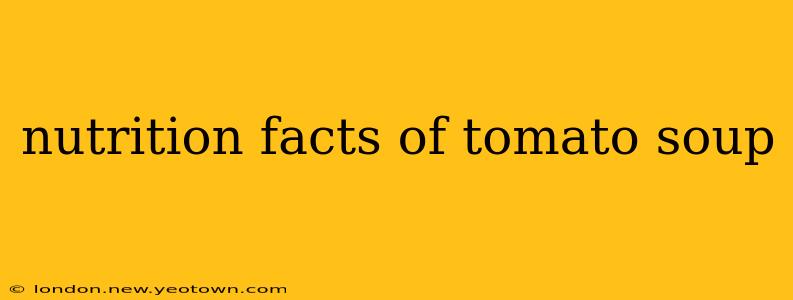Decoding the Deliciousness: A Deep Dive into Tomato Soup Nutrition
Tomato soup, a comforting classic enjoyed by millions, often evokes feelings of warmth and nostalgia. But beyond its delightful taste, lies a nutritional profile worth exploring. This isn't just about calories; it's about understanding the vitamins, minerals, and potential health benefits (and drawbacks) lurking within that vibrant red bowl. Let's unravel the nutritional facts of tomato soup, exploring variations and answering some common questions.
Our journey starts with a baseline understanding: the nutritional content of tomato soup can vary wildly depending on the recipe, ingredients, and brand. A homemade version, bursting with fresh tomatoes and minimal added ingredients, will differ significantly from a commercially produced, creamy soup brimming with sodium and added sugars.
What are the nutritional benefits of tomato soup?
Tomato soup's nutritional value hinges heavily on the quality of its ingredients. At its core, tomatoes are nutritional powerhouses, packed with:
-
Lycopene: This potent carotenoid, responsible for tomatoes' vibrant red color, is a powerful antioxidant linked to reduced risk of several cancers, heart disease, and other chronic illnesses. The cooking process actually increases lycopene bioavailability, making tomato soup a particularly good source.
-
Vitamin C: A crucial antioxidant supporting immune function and collagen production.
-
Vitamin K: Important for blood clotting and bone health.
-
Potassium: An essential electrolyte crucial for maintaining healthy blood pressure.
-
Fiber: Contributes to digestive health and can aid in feeling full and satisfied.
However, many commercially available tomato soups often fall short in these areas due to added ingredients.
How many calories are in a bowl of tomato soup?
The calorie count is highly variable. A cup of homemade tomato soup might contain anywhere from 80-150 calories, depending on ingredients like added cream, oil, or pasta. Conversely, a commercially prepared, creamy tomato soup could easily exceed 200 calories per cup, sometimes significantly more. Always check the nutrition label for specific calorie information.
Is tomato soup good for weight loss?
Tomato soup can be a part of a weight-loss diet, but it depends on the preparation. A low-calorie, low-sodium, homemade version, rich in fiber, can be a satisfying and nutritious addition to a balanced meal plan. However, creamy, high-calorie versions loaded with added sugars and fats should be consumed sparingly or avoided altogether.
How much sodium is in tomato soup?
Sodium content is a major concern, particularly in commercially produced soups. Many brands are high in sodium, contributing to potential health problems like high blood pressure. Checking the nutrition label is crucial, and opting for low-sodium or no-salt-added options is highly recommended. Homemade versions allow for complete control over sodium levels.
What are the ingredients in tomato soup?
The ingredient list can vary dramatically. Homemade versions typically involve tomatoes (fresh or canned), vegetable broth, onions, garlic, and herbs and spices. Commercial versions often include added sugar, salt, thickeners (like cornstarch or flour), and sometimes cream or other dairy products. Reading the ingredient list carefully is vital for understanding the soup's overall nutritional profile.
Is tomato soup healthy for your heart?
The health benefits for the heart depend heavily on the preparation. The lycopene and potassium in tomatoes contribute to cardiovascular health. However, high sodium content can negate these benefits, potentially increasing blood pressure. Choosing low-sodium options and controlling added fats and sugars is essential for supporting heart health.
In conclusion, tomato soup's nutritional value is a spectrum. From a nutrient-dense, homemade bowl to a sodium-laden commercial version, the variation is substantial. By being mindful of ingredients, sodium content, and added sugars, you can enjoy this comforting classic while reaping its potential health benefits. Always check nutrition labels and prioritize homemade options whenever possible for optimal nutrition control.

